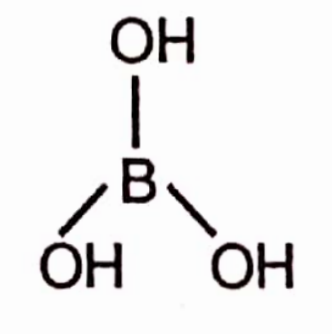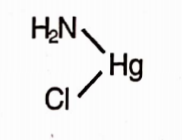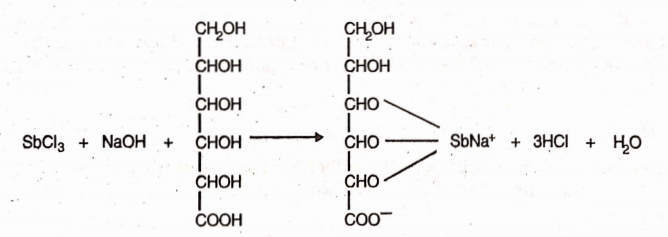Inorganic Chemistry Practicals
Inorganic Chemistry Experiment No. 1
Aim:- To prepare and standardize 1 M sodium hydroxide (NaOH) solution.
Requirements:-
Chemicals required:- Sodium hydroxide, potassium biphthalate, phenolphthalein indicator.
Glassware required:- Burette, pipette, conical flask, funnel, beaker, glass rod.
Equipment required:- Weighing balance.
Procedure:-
Preparation:
- Add about 4.2 gm of sodium hydroxide with continuous stirring.
- Add more about 700 ml of distilled water, mix and allow to cool to room temperature.
- Make up the volume 1000 ml with distilled water. Mix solution thoroughly.
Sodium Hydroxide Solution Standardization:
- Accurately weigh about 0.5 gm of potassium biphthalate, previously crushed lightly and dried at 120°C for 2 hrs.
- Dissolve in 75 ml of carbon dioxide free water.
- Add 2 drops of phenolphthalein, and titrate with sodium hydroxide solution to the production of a permanent pink colour.
- Each 20.42 mg of potassium biphthalate is equivalent to 1 ml of 0.1 N sodium hydroxide.
Calculation:
Read and Learn More Pharmaceutical Inorganic Chemistry Notes
M = Wt. of potassium biphthalate (gm) / 0.20423 * NaOH solution (ml)
Inorganic Chemistry Experiment No. 2
AIM: TO Prepare and standardize 1 M hydrochloric acid (HCl) solution.
Requirements:-
.
Chemicals required:- sodium carbonate, hydrochloric acid, methyl indicator indicator.
Glassware required:- Burette, pipette, conical flask, funnel, beaker, glass rod.
Equipment required:- Weighing balance.
Procedure:-
Preparation
.
Dilute 85 ml of hydrochloric acid with water to produce 1000 ml.
Standardization
- Weigh accurately about 1.5 gm of anhydrous sodium carbonate, previously heated to about 270°C for 1 hour.
- Dissolve it in 100 ml of water and add 0.1 ml of methyl red solution.
- Add the acid slowly from a burette, with constant stirring, until the solution become faintly pink.
- Heat the solution to boiling and titrate further as necessary until the faint pink colour is no longer affected by continued boiling.
- 1 ml of 1 M hydrochloric acid is equivalent to 0.05299 gm of Na2CO3.
Calculation
M=Na2CO3(mg) / HCl (ml) * 52.99
Inorganic Chemistry Experiment No. 3
Aim:- To prepare and standardize 0.1 N potassium permanganate (KMnO4) solution.
Requirements:-
Chemicals required:- Potassium permanganate, sodium oxalate, sulphuric acid, methyl indicator.
Glassware required:- Burette, pipette, conical flask, funnel, beaker, glass rod.
Equipment required:- Weighing balance.
Procedure:-
Preparation
- Dissolve 3.3 g of reagent grade potassium permanganate (KMnO4) in 1 L of purified water and heat on a steam bath for two hrs.
- Cover and allow to stand for 24 hrs.
- Filter through a fine porosity sintered glass crucible, discarding the first 25 mL. Store in a glass-stoppered, amber-colored bottle.
- Avoid exposure to direct sunlight; cover the neck of the bottle with a small beaker as protection against dust.
Standardization
- Weigh accurately 0.2-0.3 g sodium oxalate (Na2C2O4) (dried 2 hrs., 105-110 °C).
- Cool in a desiccator and transfer quantitatively to a 600 mL beaker.
- Add 250 mL of purified water (freshly boiled and cooled) and 10 mL sulphuric acid (96% H2S04, sp g 1.84).
- Add rapidly from a burette about 95% of the theoretical quantity of potassium permanganate solution needed; stir until the solution is clear.
- Heat the solution to 55-60 °C (Maintain temperature range during titration.) and complete the titration by slow drop wise addition until the appearance of a pink color whibh persists for 30 secs.
- Determine and subtract a blank titration run at 55-60 °C on a mixture of 250 mL of purified water (freshly boiled and cooled) and 10 mL of concentrated sulfuric acid.
Calculation
N= wt. of Na2C2O4(gm) *1000 /(Net Titre ml.) * 67.00
Inorganic Chemistry Experiment No. 4
Aim- To prepare and standardize 1 N sodium thiosulphate (Na2S2O3) solution.
Requirements:-
Chemicals required:- Sodium thiosulphate, potassium dichromate, cone, hydrochloric acid , potassium iodide.
Glassware required:- Burette, pipette, conical flask, funnel, beaker, glass rod.
Equipment required:- Weighing balance.
Procedure:-
Preparation
- Dissolve 25 g of sodium thiosulphate pentahydrate (Na2S203*5H20, 248 g/mol) in 1 liter of freshly boiled distilled water.
- For improve its stability by adding 0.1 g of Na2C03.
- Store overnight, and filter through fine grade paper, collect and store in a clean, dark glass bottle.
Standardization
- About 1.25gm of potassium dichromate is weighed out into a 250ml standard flask.
- It is dissolved in water & made up to the mark.
- 20ml of the made up solution is pipette out into a conical flask.
- About 3ml of concentrated HC1 is added, followed by 5ml of 10% potassium iodide solution.
- It is titrated against sodium thiosulphate solution from the burette using starch as indicator.
- Titration is repeated till concordant values are obtained.
Calculation
N= wt. of K2Cr2O7 (mg)/49.04 * Na2S2O3 (ml)
Inorganic Chemistry Experiment No. 5
Aim:- To prepare and standardize .05 M disodium edetate (EDTA) solution.
Requirements:-
Chemicals required:- Disodium edetate, zinc, ammonia, sodium hydroxide, mordant black II .
Glassware required:- Burette, pipette, conical flask, funnel, beaker, glass rod.
Equipment required:- Weighing balance.
Procedure:-
Preparation
Dissolve 18.6 g of disodium edetate in sufficient water to produce 1000 ml.
Standardization
- Weight accurately about 0.8 g of Granulated Zinc, dissolve by gentle warming in 12ml of diluted Hydrochloric acid and 0.1ml of bromine solution boil to remove the excess bromine, cool, add sufficient water to produce 200 ml.
- Pipette 20 ml in to a conical flask and nearly neutralize with 2 M sodium hydroxide.
- Add about 125 ml water and sufficient ammonia buffer pH 10 to dissolve the precipitate and add 5 ml in excess.
- Add 50 mg of mordant black II mixture and titrate with the prepared disodium edentate solution until the solution turns to green point.
Calculation
M = wt. of Zinc (gm) * 20/ 200 * 0.00654 * volume of EDTA (ml)
Inorganic Chemistry Experiment No. 6
Aim:- Prepare and standardize 0. 1 M silver nitrate (AgNO3) solution.
Requirements:-
Chemicals required:- Silver nitrate, acetic acid, methanol, sodium hydroxide, Eosin Y indicator
Glassware required:- Burette, pipette, conical flask, funnel, beaker, glass rod.
Equipment required:- Weighing balance.
Procedure:-
Preparation
- Take about 100 ml of water in a clean dried 1000 ml volumetric flask.
- Add about 17 gm of silver nitrate with continuous stirring.
- Add more about 700 ml of distilled water, mix.
- Make up the volume 1000 ml with water.
- Mix solution thoroughly.
- Keep the solution for at least one hour and then carry out the standardization.
Standardization
- Transfer about 50 mg, accurately weighed sodium chloride, previously dried at 110°C for 2 hours, to a 150 ml conical flask.
- Dissolve in 5 ml of distilled water.
- Add 2.5 ml of acetic acid, 25 ml methanol and about 0.25 ml of Eosin Y indicator.
- Stir with a magnetic stir.
- Titrate with the silver nitrate solution.
Calculation
M= NaCl (mg) / AgNO3 (ml) * 58.44
Primary And Secondary Standards
Primary Standard
A primary, standard is a reagent that is extremely pure, stable, it not a hydrate/has no water of hydration, and has a high molecular weight.
A primary standard should:
- Be easy to store without deteriorating or reacting with that atmosphere.
- Be readily obtainable in pure form.
- Be in expensive.
Examples of primary standards for titration of acids are:
- Sodium carbonate: Na2CO3, mol wt. = 105.99 g/mol
- Tris-(hydroxymethyl)aminomethane (TRIS or THAM): (CH2OH)3CNH2, mol wt. =121.14 g/mol
Examples of primary standards for titration of bases are:
- Potassium hydrogen phthalate (KHP): KHC8H4O4, mol wt. = 204.23 g/mol
- Potassium hydrogen iodate: KH(IO3)2, mol wt. = 389.92 g/mol
Examples of primary standards for redox titrations are:
- Potassium dichromate: K2Cr2O7, mol wt. = 294.19 g/mol
- odium oxalate: Na2C2O4 mol wt. = 134.00 g/mol
Secondary Standard
A secondary standard is a standard that is prepared in the laboratory for a specific analysis. U is usually standardized against a primary standard.
Example:
An unknown solution of HC1 may be standardized volumetrically in two ways, namely:
- By the help of ‘AnalaR’-grade Na2CO3 i.e., purity is known-primary Standard’, and
- By the help of another standard solution of NaOH—‘Secondary Standard’,
Acid-Base Titrations
Acid-base titration is based on the neutralization reaction between acid and base. In this titration, the endpoint is a condition at which the moles of acid exactly cancel out the moles of base present in a solution or vice-versa. Hence the solution is neutral.
We can use the colour indicator like litmus paper and phenolphthalein to determine the endpoint. Potassium hydrogen phthalate calcium carbonate and oxalic acid strength of sample solution.
Inorganic Chemistry Experiment No. 7
Aim:- To perform the assay of boric acid as per I.P.
Requirements:-
Chemicals required:- Boric acid (sample), sodium hydroxide, glycerol, phenolphthalein
indicator.
Glassware required:- Burette, pipette, conical flask, funnel, beaker, glass rod.
Equipment required:- Weighing balance.
Principle:- Boric acid is very weak acid with very less dissociation constant. When it reacts with glycerol, glyceroboric acid is formed and its dissociation constant is increased and it behaves like strong acid.
Given sample of boric acid is dissolved in mixture of water and glycerin (1:2) and titrated against sodium hydroxide. End point can be detected by using phenolphthalein as an indicator.
Reaction involved in this titration is as follows.

Procedure:-
Preparation of reagents and solutions:-
Preparation and standardization of sodium hydroxide (1 M)
Titration:-
- Clean and dry all glassware as per standard laboratory procedure.
- Rinse the burette with distilled water. Then, pre-rinse it with a portion of the NaOH solution before you fill it up for the titration. Pre-rinsing is necessary to ensure that all of the solution in the burette is the desired solution, not a diluted or contaminated solution.
To do this, add about 10 ml of the NaOH solution to the clean burette. Carefully turn the burette on its side so the liquid slowly runs out the top. Rotate the burette on its axis during this time to make sure the solution wets the sides all the way to the top. Pour the rinse from the burette into a waste beaker. Repeat the rinsing process with a second portion of the NaOH solution. - Weigh accurately about 1.0 g of H2BO3 in a conical flask and dissolve in mixture of 25 ml water and 50 ml glycerol.
- Add 2 drops of phenolphthalein indicator.
- Then fill the burette with standardized NaOH solution.
- Start titration with the NaOH until reach the endpoint. The first titration should be performed by adding 0.50 ml portions of NaOH solution from burette, with swirling. The approach of the endpoint is suggested by the temporary appearance of a pink colour that fades when the solution is swirled for upto 10 seconds. A pink colour that persists for more than 30 seconds signals the actual endpoint.
Note:- The solution may lose its colour after 30 seconds or more, but it is not considered. - The first titration gives a rough idea of the amount of NaOH needed to neutralize the H3BO3.
- Record the reading of burette.
- Repeat the titration three times to get precise readings. For these we can add about 70% of the needed NaOH quickly and then, near the end, add NaOH one drop at a time until the endpoint is observed.
- Take mean of them and calculate the percentage purity of H3BO3.
Observation Table:-
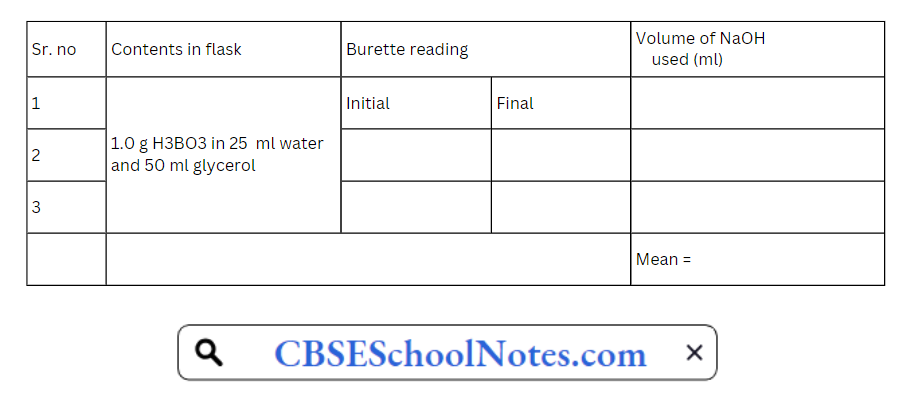
Calculations:-
Percentage purity = V X E X AM X 100/W x RM
Where,
V = volume of NaOH used (ml).
E = equivalent factor.
AM = actual molarity.
RM = required molarity.
W = weight of sample (g).
NOTE: The equivalent factor of H3BO3 for 1 ml of 1 M NaOH is 0.06183.
Result:- The percentage purity of boric acid was found to be
Inorganic Chemistry Experiment No. 8
Aim:- perform the assay of ammonium chloride as per I.P.
Requirements
Chemicals required:- Ammonium chloride (sample), sodium hydroxide, glycerol,phenolphthalein indicator.
Glassware required:- Burette, pipette, conical flask, funnel, beaker, glass rod.
Equipment required:- Weighing balance.
Principle:- Ammonium chloride is an expectorant, diuretic and systemic acidifier. It is an acidic salt which reacts with formaldehyde to liberate free acid, that free acid reacts with sodium hydroxide. End point can be detected by using phenolphthalein as an indicator. Reaction involved in this titration is as follows.
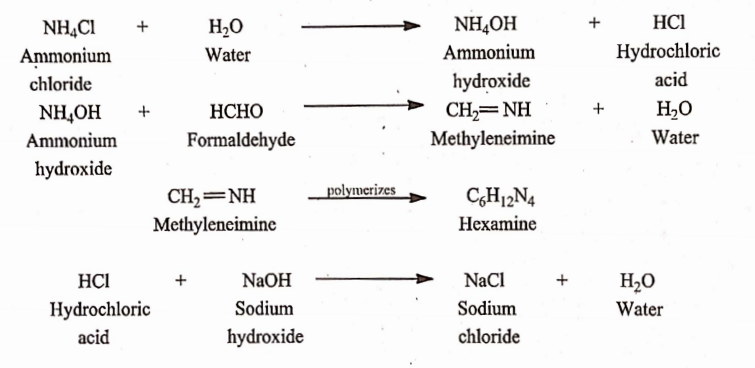
Procedure
Preparation and standardization of sodium hydroxide (0. 1 M):-
Titration:-
- Clean and dry all glassware as per standard laboratory procedure.
- Rinse the burette with distilled water. Then, pre-rinse it with a portion of the NaOH solution before you fill it up for the titration. Pre-rinsing is necessary to ensure that all of the solution in the burette is the desired solution, not a diluted or contaminated solution.
To do this, add about 10 ml of the NaOH solution to the clean burette. Carefully turn the burette on its side so the liquid slowly runs out the top. Rotate the burette on its axis during this time to make sure the solution wets the sides all the way to the top. Pour the rinse from the burette into a waste beaker. Repeat the rinsing process with a second portion of the NaOH solution. - Weigh accurately about 0.1 g of NH4CI in a conical flask and dissolve in 20 ml distilled water.
- Add a mixture of 5ml formaldehyde solution and 20 ml distilled water.
- Add 2 drops of phenolphthalein indicator and allow to stand for two minutes.
- Then fill the burette with standardized NaOH solution.
- Start titration with the NaOH until reach the endpoint. The first titration should be performed by adding 0.50 ml portions of NaOH solution from burette, with swirling. The approach of the endpoint is suggested by the temporary appearance of a pink colour that fades when the solution is swirled for upto 10 seconds. A pink colour that persists for more than 30 seconds signals the actual endpoint
Note:- The solution may lose its colour after 30 seconds or more, but it is not considered. - The first titration gives a rough idea of the amount of NaOH needed to neutralize the free HCl.
- Record the reading of burette.
- Repeat the titration three times to get precise readings. For this we can add about 70% of the needed NaOH quickly and then, near the end, add NaOH one drop at a time until the the endpoint is observed.
- Take mean of them and calculate the percentage purity of NH4CI
Observation Table:
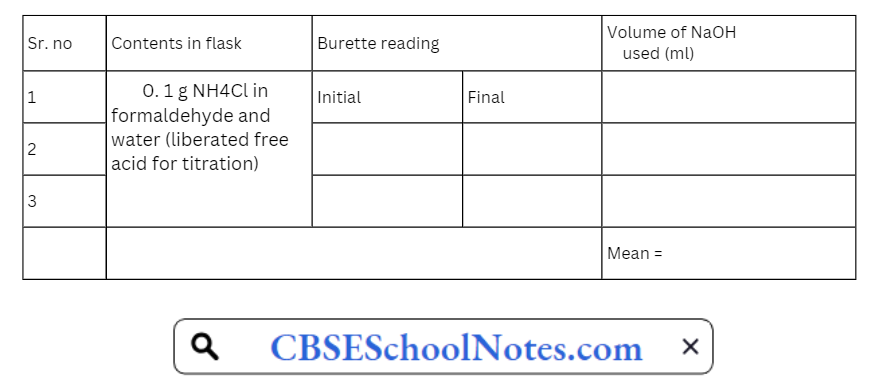
Calculations:-
Percentage purity = V x E X AM x 100/ W X RM
Where,
V = volume of NaOH used (ml).
E = equivalent factor.
AM = actual molarity.
RM = required molarity.
W= weight of sample (g).
NOTE: The equivalent factor of NH4Cl for 1 ml of 0.1 M NaOH is 0.005349.
Result: The percentage purity of ammonium chloride was found to be
Inorganic Chemistry Experiment No. 9
AIM:- To perform the assay of sodium carbonate as per I.P.
Requirements.-
Chemicals required:- Sodium carbonate (sample), sodium hydroxide, methyl orange indicator.
Glassware required:- Burette, pipette, conical flask, funnel, beaker, glass rod.
Equipment required:- Weighing balance.
PRINCIPLE:- Given sample of sodium carbonate is dissolved in water and titrated against hydrochloric acid. End point can be detected by using methyl orange as an indicator.
Reaction involved in this titration is as follows.

PROCEDURE:-
Preparation of reagents and solutions:-
Preparation and standardization of hydrochloric acid (1 M):-
Titration:-
- Clean and dry all glassware as per standard laboratory procedure.
- Rinse the burette with distilled water. Then, pre-rinse it with a portion of the HCl solution before you fill it up for the titration. Pre-rinsing is necessary to ensure that all of the solution in the burette is the desired solution, not a diluted or contaminated solution.
To do this, add about 10 ml of the HCl solution to the clean burette. Carefully turn the burette on its side so the liquid slowly runs out the top. Rotate the burette on its axis during this time to make sure the solution wets the sides all the way to the top. Pour the rinse from the burette into a waste beaker. Repeat the rinsing process with a second portion of the HCl solution. - Weigh accurately about 1.0 g of Na2CO3 in a conical flask and dissolve in 25 ml distilled water.
- Add 2 drops of methyl orange indicator.
- Then fill the burette with standardized HClsolution.
- Start titration with the HCl until reach the endpoint. The first titration should be performed by adding 0.50 ml portions of HCl solution from burette, with swirling. The approach of the endpoint is suggested by the temporary appearance of a pink colour that fades when the solution is swirled for uplo I0 seconds. A pink colour that persists for more than 30 seconds signals the actual endpoint.
Note:- The solution may lose its colour after 30 seconds or more, but it is not considered. - The first titration gives a rough idea of the amount of HCl needed to neutralize the Na2CO3.
- Record the reading of burette.
- Repeat the titration three times to gel precise readings. For this we can add about 70% of the needed HCI quickly and then, near the end, add HCI one drop at a time until the endpoint is observed.
- Take mean of them and calculate the percentage purity of Na2CO3.
Observation Table:

Calculations:-
Percentage purity =V XE xAM x 100/W x RM
Where,
V = volume of HCI used (ml).
E = equivalent factor.
AM ss actual molarity.
RM = required molarity.
W = weight of sample (g).
NOTE: The equivalent factor of sodium carbonate for I ml of 1 M HCl is 0.05299.
Result:
The percentage purity of sodium carbonate was found to be
Inorganic Chemistry Experiment No. 10
Aim:- To perform the assay of sodium bicarbonate as per I.P.
Requirements:-
Chemicals required:-Sodium bicarbonate (sample), sodium hydroxide, methyl orange indicator
Glassware required:- Burette, pipette, conical flask, funnel, beaker, glass rod.
Equipment required:- Weighing balance.
Principle:- Given sample of sodium bicarbonate is dissolved in carbon dioxide-free water and titrated against hydrochloric acid. End point can be detected by using methyl orange indicator.
Reaction involved in this titration is as follows.

Procedure:-
Preparation of reagents and solutions:-
Preparation and standardization of hydrochloric acid (1 M):-
Titration:-
- Clean and dry all glassware as per standard laboratory procedure.
- Rinse the burette with distilled water. Then, pre-rinse it with a portion of the HCl solution before you fill it up for the titration. Pre-rinsing is necessary to ensure that all of the solution in the burette is the desired solution, not a diluted or contaminated solution.
To do this, add about 10 ml of the HCl solution to the clean burette. Carefully turn the burette on its side so the liquid slowly runs out the top. Rotate the burette on its axis during this time to make sure the solution wets the sides all the way to the top. Pour the rinse from the burette into a waste beaker. Repeat the rinsing process with a second portion of the HCl solution. - Weigh accurately about 1 .5 g of Na2HCO3 in a conical flask and dissolve in 50 ml of carbon dioxide-free water.
- Add 2 drops of methyl orange indicator.
- Then fill the burette with standardized HCl solution.
- Start titration with the HCl until reach the endpoint. The first titration should be performed by adding 0.50 ml portions of HCl solution from burette, with swirling. The approach of the endpoint is suggested by the temporary appearance of a pink colour that fades when the solution is swirled for upto 10 seconds. A pink colour that persists for more than 30 seconds signals the actual endpoint.
Note:- The solution may lose its colour after 30 seconds or more, but it is not considered. - The first titration gives a rough idea of the amount of HCl needed to neutralize the
Na2HCO3. - Record the reading of burette.
- Repeat the titration three times to get precise readings. For these we can add about 70% of the needed HCl quickly and then, near the end, add HCl one drop at a time until the endpoint is observed.
- Take mean of them and calculate the percentage purity of Na2HCO3.
Observation Table:-
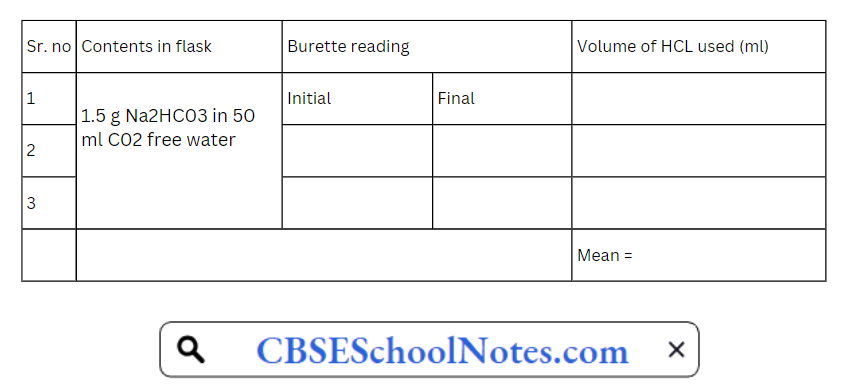
Calculations:-
Percentage purity = VxExAMx 100/W X RM
Where,
V = volume of HCl used (ml).
E = equivalent factor.
AM = actual molarity.
RM = required molarity .
W = weight of sample (g).
NOTE:- Equivalent factor of sodium bicarbonate for 1 ml of 1 M HCl is 0.08401.
Result:- The percentage purity of sodium bicarbonate was found to be
Redox Titrations
Redox titration involves the change in valency or oxidation states of reactants. Oxidation and reduction are takes place simultaneously in redox titration reaction. One substance is oxidized and other is reduced at a time.
Oxidation can be defined in following terms:-

The substance which loses electrons and get itself oxidized is called reducing agent. Some common reducing agents are antimony trioxide, ferrous sulphate, sodium thiosulphate, stannous chloride, oxalic acid etc.
Reduction can be defined in following terms:

The substance which gain electrons and get itself reduced is called oxidizing agent. Some common oxidizing agents are potassium permanganate, potassium dichromate, potassium bromate, potassium iodate etc.
Redox titrations are of following types:-
- Permanganametry:- Titrations involving potassium permanganate.
- Iodimetry:- Titrations involving iodine.
- Iodometry:- Titration involving liberated iodine.
- Chromatometry:- Titrations involving potassium dichromate.
- Bromatometry:- Titrations involving bromine.
End point in redox titrations can be detected by using external indicator (starch paper), internal indicator (methylene blue), self indicator (potassium permanganate in permanganametry).
Inorganic Chemistry Experiment No. 11
AIM:- To perform the assay of ferrous sulphate.
Requirements:-
Chemicals required:- Sulphuric acid, potassium permanganate, ferrous sulphate (sample).
Glassware required:- Burette, pipette, conical flask, funnel, beaker, glass rod.
Equipment required:- Weighing balance.
Principle:- Ferrous sulphate is mainly used as hematinic and is a reducing agent. Assay of ferrous sulphate is an example of redox titration (permangnametry). Potassium permanganate acts as an strong oxidizing agent in acidic medium that oxidizes divalent ferrous sulphate to trivalent ferric sulphate.
Known strength of potassium permanganate is titrated with ferrous sulphate. End point can be detected with appearance of permanent pink colour, potassium permanganate acts as self indicator. Reaction involved in this titration is as follows.

Procedure:-
Preparation of reagents and solutions:-
- Preparation and standardization of KMnO4 (0.1 N)
- Dilute sulphuric acid:- Dilute 57 ml of sulphuric acid to 1000 ml with distilled water.
Titration:-
- Clean and dry all glassware as per standard laboratory procedure.
- Rinse the burette with distilled water. Then, pre-rinse it with a portion of the KMnO4 solution before you fill it up for the titration. Pre-rinsing is necessary to ensure that all of the solution in the burette is the desired solution, not a diluted or contaminated solution.
To do this, add about 10 ml of the KMnO4 solution to the clean burette. Carefully turn the burette on its side so the liquid slowly runs out the top. Rotate the burette on its axis during this time to make sure the solution wets the sides all the way to the top. Pour the rinse from the burette into a waste beaker. Repeat the rinsing process with a second portion of the KMnO4solution. - Weigh accurately about 1 g of ferrous sulphate in a conical flask and dissolve in 20 ml of dilute sulphuric acid.
- Then till the burette with standardized KMn04 solution.
- Start titration with the KMnO4 solution until reach the endpoint. The approach of the endpoint is suggested by the temporary appearance of a pink colour that fades when the solution is swirled for upto 10 seconds. A pink colour that persists for more than 30 seconds signals the actual endpoint.
NOTE:-The solution may lose its colour after 30 seconds or more, but it is-not considered. - The first titration gives a rough idea of the amount of KMnO4 solution needed to reach the end point.
- Record the reading of burette.
- Repeat the titration three times to get precise readings.
- Take mean of them and calculate the percentage purity of ferrous sulphate.
Observation Table:-
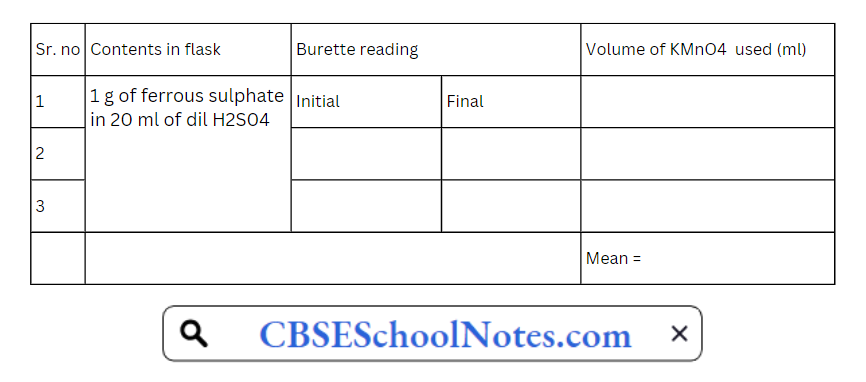
Calculations:-
Percentage purity = V x E x AN x 100/W X RN
Where,
V = volume of KMn04 used (ml).
E = equivalent factor .
AN = actual normality of KMnO4.
RN = required normality of KMnO4.
W = weight of sample (g).
NOTE:- Equivalent factor of ferrous sulphate for 1 ml of 0.1 N KMnO4 is 0.02789.
Result: The percentage purity of ferrous sulphate was found to be
Inorganic Chemistry Experiment No. 12
Aim:- To perform the assay of ferrous ammonium sulphate (Mohr’s salt).
Requirements:-
Chemicals required:- Sulphuric acid, ferrous ammonium sulphate (sample), potassium perman ganate.
Glassware required:- Burette, pipette, conical flask, funnel, beaker, glass rod.
Equipment required:- Weighing balance.
Principle:- Ferrous ammonium sulphate is also known as Mohr’s salt. Assay of ferrous ammonium sulphate is an example of redox titration (permangnametry). Potassium permanganate acts as an strong oxidizing agent in acidic medium that oxidizes divalent ferrous sulphate of mohr’s salt to trivalent ferric sulphate.
Known strength of potassium permanganate is titrated with Ferrous ammonium sulphate. End point can be detected with appearance of permanent pink
colour, potassium permanganate acts as self indicator.
Reaction involved in this titration is as follows.

Procedure:-
Preparation of reagents and solutions:-
- Preparation and standardization of KMnO4 (0.1N):-
- Dilute sulphuric acid:- Dilute 57 ml of sulphuric acid to 1000 ml with distilled water.
Titration:-
- Clean and dry all glassware as per standard laboratory procedure.
- Rinse the burette with distilled water. Then, pre-rinse it with a portion of the KMnO4 solution before you fill it up for the titration. Pre-rinsing is necessary to ensure that all of the solution in the burette is the desired solution, not a diluted or contaminated solution.
To do this, add about 10 ml of the KMnO4 solution to the clean burette. Carefully turn the burette on its side so the liquid slowly runs out the top. Rotate the burette on its axis during this time to make sure the solution wets the sides all the way to the top. Pour the rinse from the burette into a waste beaker. Repeat the rinsing process with a second portion of the KMnO4 solution. - Weigh accurately about 1 g of ferrous ammonium sulphate in a conical flask and dissolve in the mixture of 20 ml distilled water and 20 ml of dilute sulphuric acid.
- Then fill the burette with standardized KMnO4 Solution.
- Start titration with the KMnO4 solution until reach the endpoint. The approach of the endpoint is suggested by the temporary appearance of a pink colour that fades when the solution is swirled for upto 10 seconds. A pink colour that persists for more than 30 seconds signals the actual endpoint.
NOTE:- The solution may lose its colour after 30 seconds or more, but it is not considered. - Record the reading of burette.
- Repeat the titration three times to get precise readings.
- Take mean of them and calculate the percentage purity of ferrous ammonium sulphate.
Observation Table:-

Calculations:
Percentage purity = V x E x AN X 100/W x RN
Where,
V = volume of KMnO4 used (ml).
E = equivalent factor.
AN = actual normality of KMnO4.
RN = required normality of KMnO4.
W= weight of sample (g).
Note:- Equivalent factor of ferrous ammonium sulphate for 1 ml of 0.1 N KMnO4 is 0.03921.
Result:- The percentage purity of ferrous ammonium sulphate was found to be
Inorganic Chemistry Experiment No. 13
Aim: Perform the assay of copper sulphate.
Requirements:-
Chemicals required:- Sodium thiosulphate, potassium iodide, acetic acid, potassium thiocyanate, starch indicator, copper sulphate (sample).
Glassware required:- Burette, pipette, conical flask, funnel, beaker, glass rod.
Equipment required:- Weighing balance.
Principle:- Assay of copper sulphate is an example of iodometric titration. In the presence of acetic acid, Copper sulphate reacts with potassium iodide and give cupric iodide.

Cupric iodide decomposes into cuprous iodide and liberate free iodine due to unstability.

Known strength of sodium thiosulphate is titrated with liberated free iodine. End point can be detected by using starch as an indicator.

Decomposition of cupric iodide to cuprous iodide is reversible. Potassium thiocyanate is added towards the end of reaction to convert cuprous iodide into cuprous thiocyanate which is more sparingly soluble than cuprous iodide.

Procedure;-
Preparation of reagents and solutions:-
Preparation and standardization of Na2S2O3 (0.1 N):-
Titration:-
- Clean and dry all glassware as per standard laboratory procedure.
- Rinse the burette with distilled water. Then, pre-rinse it with a portion of the Na2S2O3 solution before you fill it up for the titration. Pre-rinsing is necessary to ensure that all of the solution in the burette is the desired solution, not a diluted or contaminated solution.
To do this, add about 10 ml of the Na2S2O3 solution to the clean burette. Carefully turn the burette on its side so the liquid slowly runs out the top. Rotate the burette on its axis during this time to make sure the solution wets the sides all the way to the top. Pour the rinse from the burette into a waste beaker. Repeat the rinsing process with a second portion of the Na2S2O3 solution. - Weigh accurately about 1 g of copper sulphate in a conical flask and dissolve in 50 ml of distilled water.
- Add 3 g of potassium iodide and 5 ml acetic acid.
- Add 2 to 3 drops of starch indicator.
- Then fill the burette with standardized Na2S2O3 solution.
- Start titration with the Na2S2O3 solution. Continue titration until temporary appearance of a faint blue colour that fades when the solution is swirled for upto 10 seconds. Continue further untill blue colour that persists for more than 30 seconds.
- Add 2 g of potassium thiocyanate and stirr well.
- Continue titration untill blue colour disappears.
- The first titration gives a rough idea of the amount of Na2S2O3 solution needed.
- Record the reading of burette.
- Repeat the titration three times to get precise readings.
- Take mean of them and calculate the percentage purity of copper sulphate.
OBSERVATION TABLE:-
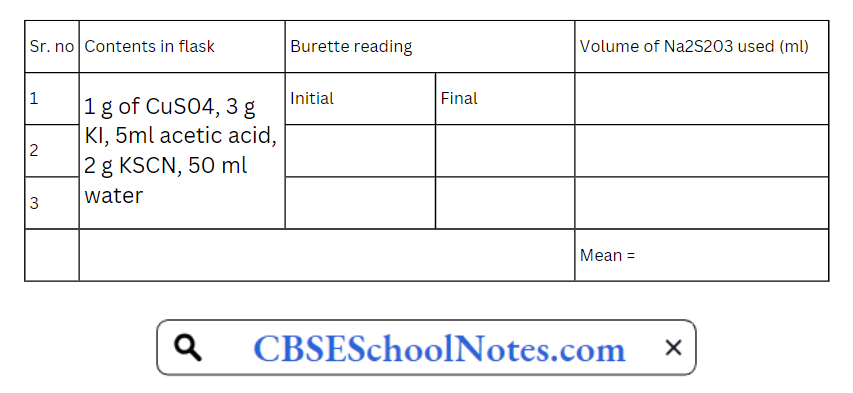
Calculations:-
Percentage purity = V x E x AN x 100/W xRN
Where,
V= volume of Na2S2O3 used (ml).
E = equivalent factor .
AN = actual normality of Na2S2O3.
RN = required normality of Na2S2O3.
W = weight of sample (g).
NOTE:- Equivalent factor of copper sulphate for 1 ml of 0.1 N Na2S2O3 is 0.02497.
Result:- The percentage purity of copper sulphate was found to be
Complexometric Titration
Complexometric titration involves titration between metal ions and complexing agent or chelating agent (Ligand). This titration is based on the analytical application of a complexation reaction.
In this method, an ion is changed into a complex ion and the equivalence point is determined with the help of metal indicators or electrometrically. An EDTA (disodium edetate) is a popular complexing agent or chilon. The chilons react with metal ions to form a special type of complex known as chelate
Inorganic Chemistry EXPERIMENT NO. 14
Aim: To perform the assay of magnesium sulphate as per I.P.
Requirements:-
Chemicals required:- Magnesium sulphate (sample), EDTA, mordant black ammonia, ammonium chloride.
Glassware required:- Burette, pipette, conical flask, funnel, beaker, glass rod.
Equipment required:- Weighing balance.
Principle:- Magnesium sulphate is titrated directly against disodium edetate in the presence of strong ammonia-ammonium chloride solution. End point is detected by mordant black 11 mixture as an indicator.
Reaction involved in this titration is as follows.

Procedure:-
Preparation of reagents and solutions:-
- Preparation and standardization of disodium edetate (0.05 M)
- Strong ammonia-ammonium chloride solution:- Mix 10 ml of water with 20 ml strong ammonia solution and saturate it with ammonium chloride.
Titration:-
- Clean and dry all glassware as per standard laboratoiy procedure.
- Rinse the burette with distilled water. Then, pre-rinse it with a portion of the disodium edetate solution before you fill it up for the titration. Pre-rinsing is necessary to ensure that all of the solution in the burette is the desired solution, not a diluted or contaminated solution.
To do this, add about 10 ml of the disodium edetate solution to the clean burette. Carefully turn the burette on its side so the liquid slowly runs out the top. Rotate the burette on its axis during this time to make sure the solution wets the sides all the way to the top. Pour the rinse from the burette into a waste beaker. Repeat the rinsing process with a second portion of the disodium edetate solution. - Weigh accurately about 0.3 g of magnesium sulphate in a conical flask and dissolve in 50 ml of distilled water.
- Add 10 ml of strong ammonia-ammonium chloride solution.
- Add 2 drops of mordant black ll mixture as an indicator.
- Then fill the burette with standardized disodium edetate solution.
- Start titration with the disodium edetate until reach the endpoint. The approach of the endpoint is suggested by the change of pink colour to blue.
- Record the reading of burette.
- Repeat the titration three times to get precise readings.
- Take mean of them and calculate the percentage purity of magnesium sulphate.
Observation Table:

Calculations:-
Percentage purity = V x E X AM x 100/W X RM
Where,
V = volume of disodium edetate used (ml).
E = equivalent factor.
AM = actual molarity.
RM = required molarity.
W = weight of sample (g).
Note:- Equivalent factor of magnesium sulphate for 1 ml of 0.05 M disodium edetate is 0.00602.
Result: The percentage purity of magnesium sulphate was found to be
Inorganic Chemistry Experiment No. 15
Aim:- To perform the assay of calcium gluconate as per I.P.
Requirements:-
Chemicals required:- Calcium gluconate (sample), EDTA, mordant black II mixture, ammonia, ammonium chloride.
Glassware required:- Burette, pipette, conical flask, funnel, beaker, glass rod.
Equipment required:- Weighing balance.
Principle:- This is a replacement titration. Magnesium forms complex with mordant black ll mixture indicator which shows first colour.

Magnesium-indicator complex is much more stable than calcium-indicator complex therefore calcium has not any effect on magnesium-indicator complex. On titration against disodium edetate complex of calcium and disodium edetate is formed.

When calcium is totally consumed, next drop of disodium edetate breaks the magnesium indicator complex and make complex with magnesium by liberating free indicator. End point is detected by observing second colour at that time.

Procedure:-
Preparation of reagents and solutions:
- Preparation and standardization of disodium edetate (0.05 M)
- Preparation of MgSO4 (0.05 M):- Accurately weigh about 600 mg of anhydrous magnesium sulphate and dissolve in 100 ml of distilled water.
- Strong ammonia-ammonium chloride solution:- Mix 10 ml of water with 20 ml strong ammonia solution and saturate it with ammonium chloride.
Titration:-
- Clean and dry all glassware as per standard laboratory procedure.
- Rinse the burette with distilled water. Then, pre-rinse it with a portion of the disodium edetate solution before you fill it up for the titration. Pre-rinsing is necessary to ensure that all of the solution in the burette is the desired solution, not a diluted or contaminated solution.
To do this, add about 10 ml of the disodium edetate solution to the clean burette. Carefully turn the burette on its side so the liquid slowly runs out the top. Rotate the burette on its axis during this time to make sure the solution wets the sides all the way to the top. Pour the rinse from the burette into a waste beaker. Repeat the rinsing process with a second portion of the disodium edetate solution. - Weigh accurately about 0.5 g of calcium gluconate in a conical flask and dissolve in 50 ml of warm water. Allow to cool.
- Add 5 ml of 0.05 M magnesium sulphate.
- Add 10 ml of strong ammonia-ammonium chloride solution.
- Add 2 drops of mordant black 11 mixture as an indicator.
- Then fill the burette with standardized disodium edetate solution.
- Start titration with the disodium edetate until reach the endpoint. The approach of the endpoint is suggested by the change in colour.
- Record the reading of burette (A)
- Repeat the titration three times to get precise readings.
- Take mean of them and calculate the percentage purity of calcium gluconate.
- Repeat the titration again using same procedure without calcium gluconate for blank reading
Observation Table:-

Calculations:-
Percentage purity = V x E x AM x 100/W X RM
Where,
V= volume of disodium edetate used (ml).
V= A-B
A = volume of EDTA used in titration with calcium gluconate.
B = volume of EDTA used in titration without calcium gluconate.
E = equivalent factor.
AM = actual molarity.
RM = required molarity.
W = weight of sample (g).
Note: The equivalent factor of calcium gluconate for 1 ml of 0.05 M disodium edetate is 0.02242.
Result:- The percentage purity of calcium gluconate was found to be
Inorganic Chemistry Experiment No. 16
AIM:- To perform the assay of calcium lactate as per I.P.
Requirements:-
Chemicals required:- Calcium lactate (sample), EDTA, mordant black 11 mixture, ammonia,anhydrous magnesium sulphate, ammonium chloride.
Glassware required:- Burette, pipette, conical flask, funnel, beaker, glass rod.
Equipment required:- Weighing balance.
Principle:- This is a replacement titration. Magnesium forms complex with mordant black 11 mixture indicator which shows first colour.

Magnesium-indicator complex is much more stable than calcium-indicator complex therefore calcium has no any effect on magnesium-indicator complex, on titration against disodium edetate complex of calcium and disodium edetate is formed.

When calcium is totally consumed, next drop of disodium edetate breaks the magnesiumindicator complex and make complex with magnesium by liberating free indicator. End point is detected by observing second colour at that time.

Procedure:
Preparation of reagents and solutionsi-
- Preparation and standardization of disodium edetate (0.05 M)
- Preparation of MgSO4 (0.05 M):- Accurately weigh about 600 mg of anhydrous magnesium sulphate and dissolve in 100 ml of distilled water.
- Strong ammonia-ammonium chloride solution:- Mix 10 ml of water with 20 ml strong ammonia solution and saturate it with ammonium chloride.
Titration:-
- Clean and dry all glassware as per standard laboratory procedure.
- Rinse the burette with distilled water. Then, pre-rinse it with a portion of the disodium edetate solution before you fill it up for the titration. Pre-rinsing is necessary to ensure that all of the solution in the burette is the desired solution, not a diluted or contaminated solution.
To do this, add about 10 ml of the disodium edetate solution to the clean burette. Carefully turn the burette on its side so the liquid slowly runs out the top. Rotate the burette on its axis during this time to make sure the solution wets the sides all the way to the top. Pour the rinse from the burette into a waste beaker. Repeat the rinsing process with a second portion of the disodium edetate solution. - Weigh accurately about 0.3 g of calcium lactate in a conical flask and dissolve in 50ml of distilled water.
- Add 5 ml of 0.05 M magnesium sulphate.
- Add 10 ml of strong ammonia-ammonium chloride sloution.
- Add 2 drops of mordant black 11 mixture as an indicator.
- Then fill the burette with standardized disodium edetate solution.
- Start titration with the disodium edetate until reach the endpoint. The approach of the endpoint is suggested by the change in colour.
- Record the reading of burette (A)
- Repeat the titration three times to get precise readings.
- Take mean of them and calculate the percentage purity of calcium lactate.
- Repeat the titration again using same procedure without calcium lactate for blank reading (B)
Observation Table:-

Calculations:-
Percentage purity = V x E x AM x 100/W X RM
Where,
V = volume of disodium edetate used (ml).
V= A-B
A = volume of EDTA used in titration with calcium lactate.
B = volume of EDTA used in titration without calcium lactate.
E = equivalent factor.
AM = actual molarity.
RM = required molarity’.
W = weight of sample (g).
NOTE:- Equivalent factor of calcium lactate for 1 ml of 0.05 M disodium edetate is 0.01091.
Result: The percentage purity’ of calcium lactate was found to be
Precipitation Titration
Precipitations titration involves the formation of precipitate. Silver nitrate is the most important precipitating agent The titration which uses silver nitrate as precipitating agent is also called argentometric titration.
End point in precipitation titrations can be detected by using potentiometric or amperometric methods, indicators like potassium chromate, ferric ammonium sulphate or by adsorption indicators like rhodamine dye.
Mohr’s method is commonly used method in precipitation titrations for determination of halides of sodium and potassium. This is also called direct method. Sodium or potassium halides are allowed to react with silver nitrate solution.
When all the halides are precipitated by silver nitrate by formation of silver halides, then silver nitrate reacts with potassium chromate solution to give a red precipitate i.e. end point, due to formation of silver chromate.
Volhard’s method is also commonly used to determine halide content in an acidic solution. Known amount of excess silver nitrate solution is allowed to react with halides, which results in precipitates of silver halide.
Precipitates are separated by filtration and excess unreacted silver nitrate solution is determined by titration with standard ammonium thiocyanate solution using ferric alum as indicator.
Inorganic Chemistry Experiment No. 17
Aim:- To perform the assay of sodium chloride. (Mohr’s method)
Requirements:-
Chemicals required:- Sodium chloride (sample), potassium chromate, silver nitrate.
Glassware required:- Burette, pipette, conical flask, volumetric flask, funnel, beaker, glass rod.
Equipment required:- Weighing balance.
Principle:- Silver nitrate is titrated directly against sodium chloride and form white precipitate silver chloride with sodium nitrate.

When all the chlorides of sodium chloride is consumed. It reacts with potassium chromate and end point can be detected with appearance of brick red colour due to formation silver chromate along with potassium nitrate.

Procedure:-
Preparation of reagents and solutions:-
1. Preparation and standardization of silver nitrate (0.1 M)
2. Preparation of sodium chloride (sample) solution:- Weigh accurately about 1 g of sodium chloride (sample) and dissolve in 100 ml of distilled water.
3. Preparation of potassium chromate solution (5% w/v):- Weigh accurately about 5 g of potassium chromate and dissolve in 100 ml distilled water.
Titration:-
- Clean and dry all glassware as per standard laboratory procedure.
- Rinse the burette with distilled water. Then, pre-rinse it with a portion of the silver nitrate solution before you fill it up for the titration. Pre-rinsing is necessary to ensure that all of the solution in the burette is the desired solution, not a diluted or contaminated solution.
To do this, add about 10 ml of the silver nitrate solution to the clean burette. Carefully turn the burette on its side so the liquid slowly runs out the top. Rotate the burette on its axis during this time to make sure the solution wets the sides all the way to the top. Pour the rinse from the burette into a waste beaker. Repeat the rinsing process with a second portion of the silver nitrate solution. - Take 10 ml of sodium chloride (sample) solution in a conical flask.
- Add 2 to 3 drops of potassium chromate solution as an indicator.
- Then fill the burette with standardized silver nitrate solution.
- Start titration with the silver nitrate solution until reach the endpoint. The approach of the endpoint is suggested by the appearance of brick red colour.
- Record the reading of burette.
- Repeat the titration three times to get precise readings.
- Take mean of them and calculate the percentage purity of sodium chloride.
Observation Table:-
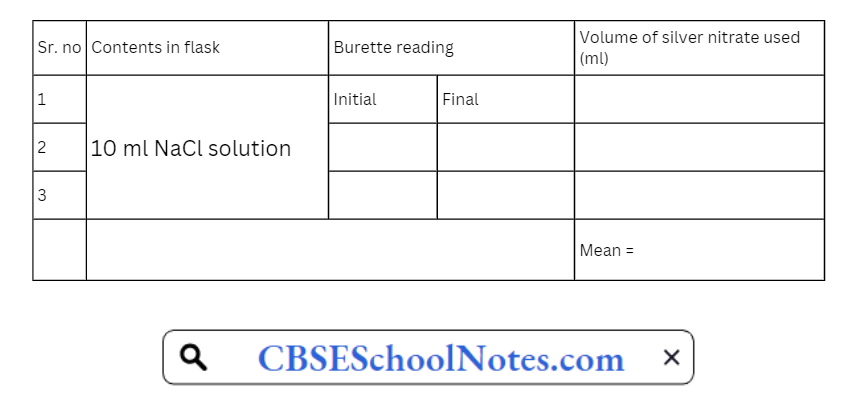
Calculations:
Percentage purity = V x E x AM x 100/ W xRM
Where,
V = volume of silver nitrate used (ml).
E = equivalent factor.
AM = actual molarity.
RM = required molarity.
W = weight of sample (g).
NOTE:- Equivalent factor of sodium chloride for 1 ml of 0.1 M silver nitrate is 0.005845 .
Result: The percentage purity of sodium chloride was found to be
Inorganic Chemistry Experiment No. 18
Aim:- To perform the assay of potassium chloride. (Mohr’s method)
Requirements:-
Chemicals required:- Potassium chloride (sample), potassium chromate, silver nitrate.
Glassware required:- Burette, pipette, conical flask, volumetric flask, funnel, beaker, glass rod.
Equipment required:- Weighing balance.
Principle:- Silver nitrate is titrated directly against potassium chloride and form white precipitate silver chloride with potassium nitrate.

When all the chloride of potassium chloride is consumed. It reacts with potassium chromate and end point can be detected with appearance of brick red colour due to formation silver chromate along with potassium nitrate.

Procedure:
Preparation of reagents and solutions:-‘
- Preparation and standardization of silver nitrate (0.1 M):-
- Preparation of potassium chloride (sample) solution:- Weigh accurately about 1 g of potassium chloride (sample) and dissolve in 100 ml of distilled water.
- Preparation of potassium chromate solution (5% w/v):- Weigh accurately about 5 g of potassium chromate and dissolve in 100 ml distilled water.
Titration:
- Clean and dry all glassware as per standard laboratory procedure.
- Rinse the burette with distilled water. Then, pre-rinse it with a portion of the silver nitrate solution before you fill it up for the titration. Pre-rinsing is necessary to ensure that all of the solution in the burette is the desired solution, not a diluted or contaminated solution.
To do this, add about 10 ml of the silver nitrate solution to the clean burette. Carefully turn the burette on its side so the liquid slowly runs out the top. Rotate the burette on its axis during this time to make sure the solution wets the sides all the way to the top. Pour the rinse from the burette into a waste beaker. Repeat the rinsing process with a second portion of the , silver nitrate solution. - Take 10 ml of potassium chloride (sample) solution in a conical flask.
- Add 2 to 3 drops of potassium chromate solution as an indicator.
- Then fill the burette with standardized silver nitrate solution.
- Start titration with the silver nitrate solution until reach the endpoint. The approach of the endpoint is suggested by the appearance of brick red colour.
- Record the reading of burette.
- Repeat the titration three times to get precise readings.
- Take mean of them and calculate the percentage purity of potassium chloride.
Observation Table:-

Calculations:-
Percentage purity = V x E x AM x 100/ W xRM
Where,
V = volume of silver nitrate used (ml).
E = equivalent factor.
AM = actual molarity.
RM = required molarity.
W = weight of sample (g).
NOTE:- Equivalent factor of potassium chloride for 1 ml of 0.1 M silver nitrate is 0.007455.
Result:- The percentage purity of potassium chloride was found to be :
Non-Aqueous Titration
Non-aqueous titration involves the use of non aqueous solvents in it. Non-aqeous titrations are method of choice when reactants or products are insoluble in water, react with water or too weak acids or bases that cannot be titrated in water due to its levelling effect.
Commonly used solvents in non aqueous titrations are acetone, glacial acetic acid, formic acid, ethylene diamine, acetic anhydride and chloroform etc. End point can be detected by the indicators like crystal violet (0.5% in glacial acetic acid) and quinaldine red (0.1% in methanol) and by potentiometric methods.
Section D
Limit Test
Limit test is defined as quantitative or semiquantitative test designed to identify and control small quantity of impurity which is likely to be present in the substance. Limit test is generally carried out to determine the inorganic impurities present in the compound.
Limit test for chlorides, sulphates, iron, lead and heavy metal are carried out in Nessler cylinders. Nesseler cylinders are made up of borosilicate glass that is colourless.
It has the fixed diameter, length as per according to the Indian Pharmacopeia. Two similar kind of cylinders are required each time i.e. one for the ‘Test’ sample and other for the ‘standard’ to make comparison in the identical manner.
The quantities of the sample vary according to the limits of impurities while the standard remains constant. No numerical values for ths limits in these tests are prescribed in the pharmacopoeias, as it is not practicable.
Generally an aqueous solution of the substance is prepared. Sometimes a solution of the substance is prepared by dissolving in an acid or if the solution is alkaline it is neutralized with nitric or hydrochloric acid as specific in the monograph of the pharmacopoeia.
The extent of opalescence, turbidity and colour is affected by other impurities present in the substance.
Inorganic Chemistry Experiment No. 19
AIM:- To perform the limit test for chlorides in the given sample (magnesium sulphate).
Requirements:–
Chemicals required:- Sodium chloride, silver nitrate, sample (magnesium sulphate), dilute nitric
acid.
Glassware required:- Pair of Nessler cylinder, volumetric flask, beaker, measuring cylinder,glass rod, spatula, pipette.
Equipment required:- Weighing balance.
Principle:- This test is based on reaction between chloride ion and silver nitrate in the presence of nitric acid. It is an argentometric titration reaction. In this reaction chlorides are precipitated silver chloride.
When a small quantity of chloride ion is present in solution silver chloride shows opalescence while in large amount it precipitates. Opalescence of test sample is compared with standard in limit test for chlorides.

Procedure:-
Preparation of reagents and solutions:
- Chloride standard solution (25 ppm chlorides):- Take 5 ml of 0.0824 % w/v solution of NaCl in 100 ml volumetric flask and make upto the mark with distilled water.
- Silver nitrate solution (0.1 M):- Dissolve 1.69 g of silver nitrate in 60 ml distilled water in 100 ml volumetric flask and make upto 100 ml with distilled water.
Preparation of test solution:-
- Weigh accurately about 1 g of magnesium sulphate or sample .
- Dissolve it in 10 ml of distilled water.
- Transfer the solution in Nessler cylinder and label it as “Test “.
- Add 10 ml dilute nitric acid.
- Make upto 50 ml mark with distilled water.
- Now add 1 ml 0.1 M silver nitrate solution in it.
- Stir with the glass rod and set aside for 5 minutes.
Preparation of standard solutions
- Add 10 ml standard chloride solution in Nessler cylinder and label it as “Standard “.
- Make upto 50 ml mark with distilled water.
- Now add 1 ml 0. 1 M silver nitrate solution in it.
- Stir with the glass rod and set aside for 5 minutes.
Observation:- Compare the opalescence of both test and standard solutions and write the observalion as follows:-
- If Test solution shows more opalescence than standard-limit test fails.
- If Test solution shows less opalescence than standard-limit test pass.
NOTE:- Compare these solutions in dark background i.e. black to get good contrast for comparison of the solutions.
Result:- Civen sample of magnesium sulphate pass / fails the limit test for chlorides.
Inorganic Chemistry Experiment No. 20
Aim:- To perform the limit test for sulphates in given sample (sodium bicarbonate).
Requirements:
Chemicals required:- Sample (sodium bicarbonate), barium chloride, acetic acid, potassium sulphate.
Glassware required:- pair 0f Nessler cylinder, volumetric flask, beaker, measuring cylinder,glass rod, spatula, pipette.
Equipment required:- Weighing balance.
Principle: When sulphates interacts with barium chloride in the presence of acetic acid,sulphates precipitate as barium sulphate. When a small quantity of sulphates are present in solution, barium sulphate shows opalescence. The opalescence of test sample is compared with standard in limit test for sulphates.
To prevent the precipitation of other anions like phosphate, oxalate, borate etc with solution of barium chloride (which can affects the results), acetic acid is added. Therefore, in the presence of acetic acid, only sulphates are precipitated.

Procedure:-
Preparation of reagents and solutions:*
- Barium chloride solution (25 % w/v):- Dissolve 25 g of barium chloride in 100 ml distilled water stir well with glass rod .
- Ethanolic sulphate standard solution (10 ppm SO4-):- Take 1ml of 0.181% w/v solution of potassium sulphate in ethanol (30%) in 100 ml volumetric flask and make upto 100 ml with ethanol (30%).
- Sulphate standard solution (10 ppm SO4-):- Take
potassium sulphate in distilled water in 100 ml volumetric flask and make upto 100 ml with distilled water. - Sodium bicarbonate solution:- Dissolve 1.0 g of sodium bicarbonate in 1 ml of distilled water, then neutralize it with hydrochloric acid and dilute upto 15 ml with distilled water.
Preparation of test solution:-
- 1. Take lml barium chloride solution (25 % w/v) in Nessler cylinder.
- Now add 1.5 ml of ethanolic sulphate standard solution (10 ppm SO2-4“) in it.
- Mix well and allow to stand it for 1 minute.
- Add 15 ml solution of sodium bicarbonate in it.
- Add 0.15 ml of 5 M Acetic acid.
- Make upto 50 ml with distilled water.
- Stir with the glass rod and set aside for 5 minutes.
Preparation of Standard solution:-
- Take 1 ml Barium chloride solution (25 % w/v) in Nessler cylinder.
- Now add 1.5 ml of ethanolic sulphate standard solution (10 ppm SO2-4) in it.
- Mix well and allow to stand it for 1 minute.
- Add 15 ml sulphate standard solution (10 ppm SO2-4) in it.
- Add 0.15 ml of 5 M acetic acid.
- Make upto 50 ml with distilled water.
- Stir with the glass rod and set aside for 5 minutes.
Observation:- Compare the opalescence of both test and standard solutions and write the observation as foliows:-
- If test solution shows more opalescence than standard – limit test fails.
- If test solution shows less opalescence than standard – limit test pass.
NOTE:- Compare these solutions in dark background i.e. black to get good contrast for comparison of the solutions.
Result:- Given sample of sodium chloride pass/fails the limit test for sulphates.
Inorganic Chemistry Experiment No. 21
Aim: To perform the limit text for iron of given sample (sodium chloride).
Requirements:
Chemicals required:- Sample (sodium chloride), iron free citric acid solution (20% w/v) iron free ammonia solution, feme ammonium sulphate, thioglycollic acid, sulphuric acid.
Glassware required:- Pair of Ncsslcr cylinder, volumetric flask, beaker, measuring cylinder, glass rod, spatula, pipette.
Equipment required – Weighing balance.
Other requirements – pH paper.
Principle:- When iron interacts with thioglycollic acid in the presence of citric acid and the ammoniacal alkaline medium, ferrous salt of thioglycollic acid is produced which gives purple colour.
Colour intensity of lest sample is compared w ith standard in limit test for iron. To prevent the precipitation of iron with ammonia as iron hydroxides, citric acid is added. This keeps iron in solution form in the presence of ammonia.
NOTE:- Reagents used in this test must be completely free from iron otherwise false results will obtained.

Procedure:
Preparation of reagents and solutions:
- Sodium chloride or sample, distilled water, iron free citric acid solution (20% w/v), iron free ammonia solution, thioglycollic acid.
- Iron standard solution (20 ppm Fe):- Take 1 ml of 0.1726 % w/v solution ferric ammonium sulphate in 0.05 M sulphuric acid make upto 10 ml with distilled water.
Preparation of test solution:-
- Weigh accurately about I g of sodium chloride or sample.
- Dissolve it in 40 ml of distilled water.
- Transfer the solution made in step 2 in Nessler cylinder and label it as “Test “.
- Add 2 ml iron free citric acid solution (20% w/v).
- Now add 0. 1 ml thioglycollic acid in it .
- Alkaline the solution with iron free ammonia solution.
- Dilute the solution upto 50 ml with distilled water.
- Stir with the glass rod and set aside for 5 minutes.
Preparation of Standard solution:-
- Add 2 ml iron standard solution (20 ppm Fe) in Nessler cylinder and label it as “Standard .
- Make upto 40 ml mark with distilled water.
- Add 2 ml iron free citric acid solution (20% w/v).
- Now add 0.1 ml thioglycollic acid in it.
- Alkaline the solution with iron free ammonia solution.
- Dilute the solution upto 50 ml with distilled water.
- Stir with the glass rod and set aside for 5 minutes.
OBSERVATION:- Compare the colour of both test and standard solutions and write the observation as follows:-
- If test solution shows more colour than standard – limit test fails.
- If test solution shows less colour than standard – limit test pass.
Results- Given sample of sodium chloride pass/fails the limit test for iron.
Inorganic Chemistry Experiment No. 22
Aim:- To perform the limit test for heavy metais in given sample (sodium chloride).
Requirements:-
Chemicals required:- Sample (sodium chloride), hydrochloric acid, sulphuric acid, ammonia solution, saturated hydrogen sulphide solution, lead nitrate, nitric acid.
Glassware required:- pair 0f Nessler cylinder, volumetric flask, beaker, measuring cylinder, glass rod, spatula, pipette.
Equipment required:- Weighing balance.
Other requirements:- pH paper.
Principle: When hydrogen sulphide reacts with heavy metals (i.e. lead, antimony, bismuth ,tin, cobalt, manganese) in the presence of acidic medium, it produces metal sulphides.
These metal sulphides are distributed in colloidal state and produce brownish colour. Colour intensity of test sample is compared with standard in limit test for heavy metals.
NOTE:- Heavy metals like lead, antimony, bismuth, tin, cobalt, manganese are grouped together for their limit test in Indian. Pharmacopoeia and their quantity is expressed in the terms of lead.

PROCEDURE:-
Preparation of reagents and solutions
- Standard lead solution (20ppm):- Weigh accurately about 400 mg of lead nitrate in distilled water containing 2 ml of nitric acid and dilute upto 250 ml. Take 10 ml of this solution and dilute upto 100 ml. Further take 10 ml of this solution and dilute upto 50 ml with distilled water.
- Dilute acetic acid:- Dilute 57 ml of glacial acetic acid to 1000 ml with distilled water.
For Colourless Substances:-
Preparation of test solution:-
- Take 25 ml solution of test sample in Nessler cylinder and label it as “Test
NOTE:- Prepare solution of test sample as directed in pharmacopoeia or otherwise dissolve specified quantity of test sample in 25 ml distilled water. - Adjust the pH of solution between 3.0 to 4.0 with dilute acetic acid.
- Dilute upto 35 ml with distilled water.
- Mix well with glass rod.
- Now add 10 ml of freshly prepared saturated solution of hydrogen sulphide.
- Make the volume upto 50 ml with distilled water.
- Stir with the glass rod and set aside for 5 minutes.
Preparation of standard solution:-
- Take 2 ml standard lead solution (20 ppm) in Nessler cylinder and label it as “Standard “.
- Make upto 2 ml with distilled water.
- Adjust the pH of solution between 3.0 to 4.0 with dilute acetic acid.
- Dilute upto 35 ml with distilled water.
- Mix well with glass rod.
- Now add 10 ml of freshly prepared saturated solution of hydrogen sulphide.
- Make the volume upto 50 ml with distilled water.
- Stir with the glass rod and set aside for 5 minutes.
For Coloured Substances
Preparation of test solution:-
- Accurately weigh a quantity of substance as directed in pharmacopoeia or otherwise weigh specified quantity of sustance in a crucible.
- Wet it by sufficient quantity of sulphuric acid
- Ignite at low temperture until thoroughly charred.
- Add 2 ml nitric acid in charred mass and 5 drops of sulphuric acid.
- Heat until, white fumes no longer evolved from it.
- Ignite it, until carbon is completey burnt off at 500 to 600 °C.
- Allow to cool and add 4 ml hydrochloric acid in it.
- Digest it on water bath for about 15 minutes and evaporate to dryness.
- Add 1 drop of hydrochloric acid to moisten the residue.
- Now add 10 ml hot water and digest for 2 minutes.
- Alkaline the solution with dropwise addition of ammonia solution (just alkaline to the litmus paper).
- Make upto 25 ml with distilled water.
- Adjust the pH of solution between 3.0 to 4.0 with dilute acetic acid.
- Dilute upto 35 ml with distilled water.
- Mix well with glass rod .
- Now add 10 ml of freshly prepared saturated solution of hydrogen sulphide.’
- Make the volume upto 50 ml with distilled water.
- Stir with the glass rod and set aside for 5 minutes.
Preparation of Standard solution:-
Procedure same as Preparation of standard solution for colourless substances.
Observation:- Compare the colour of both test and standard solutions and observation as follows:-
- If test solution shows more colour than standard – limit test fails.
- If test solution shows less colour than standard – limit test pass.
Result: Given sample Of sodium chloride pass/ fails thnimit ttst for heavy metal (lead, antimony, bismuth, tin, cobalt, manganese).
Inorganic Chemistry Experiment No. 23
Aim:- To perform (he limit test for arsenic in given sample (ammonium chloride).
Requirements:-
Chemicals required:- Sample (ammonium chloride), granulated zinc, potassium iodide, arsenic trioxide, sodium hydroxide, stannous chloride solution.
Glassware required:- Volumetric flask, beaker, measuring cylinde, glass rod, spatula, pipette.
Equipment required:- jwo sets of arsenic test apparatus, weighing balance.
Other requirements:- Cotton, mercuric chloride paper.
Principle:- when sample containing arsenic is dissolved in acid, arsenic impurity get converted into arsenious acid (trivalent) or arsenic acid (pentavalent) depending upon the valency state of arsenic present in sample.

On treatment with stannous chloride (reducing agent) pentavalent arsenic acid is converted into trivalent arsenious acid.
NOTE:- Potassium iodide is used in test because it facilitate the conversion of pentavalent arsenic acid into trivalent arsenious acid.

On treatment with stannous chloride (reducing agent) pentavalent arsenic acid is converted into trivalent arsenious acid.

With the help of nascent hydrogen produced by Zn + HCl, arsenious acid is converted into arsine gas (gaseous arsenious hydride)
Produced arsine gas is carried out through the tube by passing through mercuric chloride paper .When arsenic gas reacts with mercuric chloride, brown or yellow stain is produced on mercuric chloride paper. Intensity of colour produced is proportional to the quantity of arsenic present.

Similarly,, stain is produced for standard solution of arsenic and intensity of two stains is compared and results are noted down.
NOTE:- Reagents used in this test must be completely free or low in arsenic otherwise false results will obtained. They are commercially available.
Arsenic test apparatus: A wide-mouth Slass bottle which is fitted with a rubber bung and a glass tube with 200 mm length with internal diameter 6.5 mm and outer diameter 8.0 mm is passes through it.
Upper end of this tube is open and lower end is tapered by reducing diameter to l (diameter of glass tube is reduced at lower end for slow and smooth passage of arsine gas ).
At the side of lower end, a hole of 2 mm diameter is made from where the lower end starts tapering (this hole is made for the alternate passage for arsine gas if water condenses at lower end ).
Cotton wool moistened with lead acetate solution, dried and packed in glass tube. Lead cotton trap hydrogen sulphide gas if any, which can interfere with the test by giving stain on mercuric chloride paper.
Upper end of tube is fitted with two rubber bungs and act like tube of 6.5 mm diameter with the help of clips enclosing flat mercuric chloride paper in it.
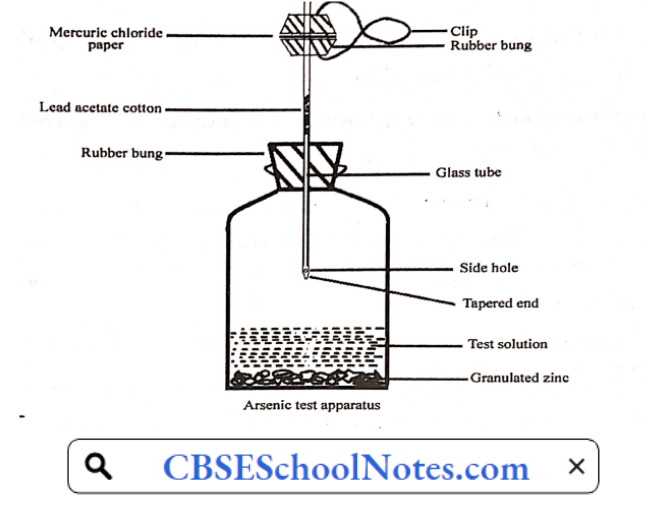
Procedure:-
Preparation of reagents and solutions:-
- Arsenic standard solution (10 ppm As):- Weigh accurately 0.330 g of arsenic trioxide and dissolve it in 5 ml of 2 M sodium hydroxide solution, dilute upto 250 ml with distilled water. Take 1ml of this solution and make upto 100 ml with distilled water.
- Stannated hydrochloric acid:- Add 1 ml of stannous chloride solution and make upto 100 ml with hydrochloric acid.
Preparation of test solution:-
- Add 50 ml distilled water in arsenic test apparatus bottle label this apparatus as “Test
- Weigh accurately and dissolve 2.5 g of ammonium chloride sample in it.
- Now add 10 ml stannated hydrochloric acid.
- Add 5 ml solution of 1 M potassium iodide.
- Now add 10 g of granulated zinc.
- Quickly place prepared glass lube at its position and allow to stand for 40 minutes.
Preparation of standard solutions-
- Add 50 ml distilled water in arsenic test apparatus bottle and label tills apparatus as Standard .
- Now add and mix 1 ml of arsenic standard solution (10 ppm As) in it.
- After mixing of step 2, add 10 ml stannated hydrochloric acid.
- Add 5 ml solution of I M potassium iodide.
- Now add 10 g of granulated zinc.
- Quickly place prepared glass tube at its position and allow to stand for 40 minutes.
Observation:- Compare the yellow stain of both test and standard solutions and write the observation as follows:-
- If test solution show yellow stain with more intensity than standard – limit test fails.
- If test solution show yellow stain with less intensity than standard – limit test pass.
Result:- Given sample of ammonium chloride pass/fails the limit test for arsenic.
Inorganic Chemistry Experiment No. 24
Aim:- To perform modified limit test for chloride.
Requirements:-
Chemicals required:- Sodium benzoate, sodium salicylate, crystal violet, hypophosphorus acid
Glassware required:- Ncsslcr cylinder, measuring cylinder, glass road, beaker.
Procedure:
A specified amount of the substance is dissolved in distilled water, and the volume made up to 50 ml in a Nessler cylinder. Depending upon the nature of the substance, some modifications have to be adopted for the preparation of the solution.
- Alkaline substances have to be dissolved in acid so that effervescence ceases and much of the free acid is left in the solution as is prescribed in the test.
- Insoluble substances are generally extracted with water and then filtered, and the filtrate is used for the test, because the presence of insoluble substance modifies the opalescence and colour.
- Salts of organic acids like sodium benzoate, sodium, salicylate, etc. liberate free water insoluble organic acid during acidification which is filtered off and the filtrate is employed for the test.
- Coloured substances like crystal violet, malachite green, etc. are carbonised and the ash so produced is extracted in water.
- Deeply coloured substances have to be decolourised before test e.g., potassium permanganate is reduced by boiling with alcohol and the filtrate is used.
- Reducing substances like hypophosphorus acid, which react with silver nitrate in the limit test for chlorides should be oxidized with nitric acid or some other oxidizing agents before carrying out the test.
Inorganic Chemistry Experiment No. 25
Aim:- To perform modified limit test for sulphate.
Requirements:-
Chemicals required:- Sodium benzoate, sodium salicylate, crystal violet, hypophosphorus acid
Glassware required:- Nessler cylinder, measuring cylinder, glass road, beaker.
Procedure:
A specified amount of the substance is dissolved in distilled water, and the volume made up to 50 ml in a Nessler cylinder. Depending upon the nature of the substance, some modifications have to be adopted for the preparation of the solution.
- Alkaline substances have to be dissolved in acid so that effervescence ceases and much of the free acid is left in the solution as is prescribed in the test.
- Insoluble substances are generally extracted with water and then filtered, and the filtrate is used for the test, because the presence of insoluble substance modifies the opalescence and colour.
- Salts of organic acids like sodium benzoate, sodium salicylate, etc. liberate free water insoluble organic acid during acidification which is filtered off and the filtrate is employed for the test.
- Coloured substances like crystal violet, malachite green, etc. are carbonised and the ash so produced is extracted in water.
- Deeply coloured substances have to be decolourised before test e.g., boiling with alcohol reduces potassium permanganate and the filtrate is used.
- Reducing substances like hypophosphorus acid, which react with silver nitrate in the limit test for chlorides should be oxidized with nitric acid or some other oxidizing agents before carrying out the test.
Section E
Identification Test
Identification tests are performed to determine the qualitative characteristics of material under examination. For the identification of inorganic drugs and pharmaceutical aids the tests are generally based on reactions of an anion and cation present in a molecule.
Identification Tests:
Aim: Identification tests are performed for the ferrous sulphate
Tests for Ferrous Salts:
Dissolve a quantity of the substance being examined equivalent to about 1 0 mg of iron in 1 ml of water or use 1 ml of prescribed solution. Add 1 ml dilute H2SO4and 0.1% w/v solution of 1,10-phenanthroline (1ml), an intense red colour is produced, which is discharged by addition of 0.1 M cerric ammonium sulphate is produced.
To a 1 ml solution containing net less than 1 mg of iron, add 1 ml potassium ferricyanide solution, a dark blue precipitate is formed that is insoluble in dilute HCl and is decomposed by sodium hydroxide solution.

To a 1 ml of solution containing not less than 1 mg of iron add 1 ml potassium ferrocyanide solution, a white precipitate is formed which is rapidly become blue and us insoluble in dilute HCl.

Tests for Sulphate:
Dissolve about 50 mg of the substance being examined in 5 ml of water or use 5 ml of prescribed solution. Add 1 ml of dilute HCl and 1 ml of barium chloride solution; a white precipitate is formed.

Add 0.1 ml of iodine solution to the suspension obtained in the test (1); the suspension remains yellow but is decolorised by adding stannous chloride solution drop wise. Boil the mixture; no coloured precipitate appears.
Dissolve the 50 mg Of substance being examined in 5 ml of water and add 2 ml of lead acetate solution; a white precipitate is formed which is soluble in ammonium acetate solution and in sodium hydroxide solution is produced .

Aim: Identification test for sodium bicarbonate
Tests for Sodium:
Dissolve 0.1 gm of the substance being examined in water and add 2ml of 15% w/v solution of potassium carbonate; heat to boiling; no precipitated is produced.
Add freshly prepared 4ml potassium antimonate solution and heat to boiling. Allow to cool in ice and if necessary scratch the inside of the test tube with help of glass rod; a dense, white precipitate is produced.

Acidify a solution of the substance being examined with IMacetic acid and add excess of magnesium uranyl acetate solution, a crystalline, yellow precipitate is formed.

Tests for Bicarbonate
Solutions of bicarbonate, when boiled, liberate CO2

Treat a solution of the substance being examined with a solution of magnesium sulphate; no precipitated is produced. Boil, white precipitate is formed.

Introduce into a test tube the 0.1 gm of the substance being examined suspended in 2 ml of water.
Add 2ml of 2M acetic acid, close the test tube immediately using a stopper fitted with a glass tube bent at two right angles, heat gently and collect the gas in 5 ml barium hydroxide solution; a white precipitate is produced that dissolve on addition of an excess of dilute HCl solution.

Aim: Identification test Calcium gluconate
Tests for Gluconic Acid:
To a solution of 3% w/v calcium gluconate (1 ml), add few drops of ferric chloride solution, a yellow colour appears.
Gluconic acid is an a-hydroxy acid. It reacts with ferric chloride to form a yellow floured complex.
To the sample (0.75 gm) in warm water (7.5 ml), add glacial acetic acid (1 ml) and freshly distilled phenylhydrazine (1.5 ml). Heat the mixture on a water bath for half an hour and allow to cool.
Scratch the inner surface of the tube with a glass rod until crystals of gluconic acid phenylhydrazine begin to form. Keep the test for 10 minutes, filter,dissolve the precipitate in hot water (10 ml), add small amount of decolourising charcoal and filter.
Allow to cool and scratch the test tube to recover the white crystals which melt at about 200°C with decomposition. Phenylhydrazine forms gluconic acid phenylhydrazine with gluconic acid which is purified by boiling with chalcoal and identified on the basis of melting point determination.
Tests for calcium Ion:
Dissolve 20 mg of substance being examined in 5M acetic acid (5ml) or add 1 ml glacial acetic.acid. Add 0.5 ml potassium ferrocyanide solution, the solution remains clear. Add 50 mg. ammonium chloride; a crystalline, white precipitate is produced.

To a 0.4 % w/v solution of the substance (5 ml) add 0.2 ml of 2% w/v solution of ammonium oxalate; a white precipitate is obtained that is only sparingly soluble in dilute acetic acid but is insoluble in hydrochloric acid.

Dissolve 20 m of the substance being examined in the minimum quantity of dilute HCl and neutralize with dilute NaOH solution.
Add 5ml ammonium’carbonate solution, a white precipitate is formed which after boiling and cooling is only sparingly soluble in ammonium chloride solution.

Inorganic Chemistry Experiment No. 26
Aim:- Identification test are performed for magnesium hydroxide.
Requirements:
Chemicals required:- Ammonium chloride, disodium hydrogen phosphate, amrponium hydroxide.
Test for Magnesium Salt:
15 gm of substance is dissolved in 2 ml of water and added 1ml of dilute ammonia solution to it; a white precipitate forms that is redissolved by adding 1ml of 2M ammonium chloride.
1 ml of 0.25 M disodium hydrogen phosphate is added; a white crystalline precipitate forms.
Ammonium chloride prevents precipitation by a common ion effect, it prevents precipitation of magnesium hydroxide due to suppression of dissociation of ammonium hydroxide.
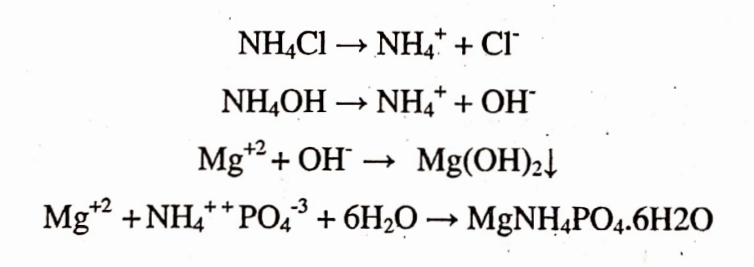
Test for Hydroxide ion
Alkaline solution tests. When mixed with an ammonium salt and heated gently it produces an alkaline gas (fumes turn universal indicator paper blue)
Inorganic Chemistry Experiment No. 27
Aim:- To perform the identification test for copper sulphate.
Requirements:-
Chemicals required:-Hyrochloric acid, potassium ferrocyanide TS, ammonium hydroxide.
Test for Copper Salt
Solution of cupric compounds, acidified with HCl, deposit a red film of metallic copper upon a bright, untarnished surface of metallic ion. Added an excess of 6N ammonium hydroxide to a solution of cupric salt, produce first a bluish precipitate than a deep blue coloured solution.
Solution of cupric salts yield a reddish-brown precipitate with potassium ferrocyanide TS, insoluble in dilute acid.
Tests For Purity
Inorganic Chemistry Experiment No. 28
Aim:-To perform the swelling index of bentonite.
Requirement:-
Chemicals required:-Bentonite, Sodium Lauryl sulphate.
Apparatus required:- Beaker, glass rod, watch-glass, measuring cylinder.
Theory:-
It is a colloidal hydrated aluminum silicate which occurs naturally. The swell index is used to determine the general characteristics of bentonite. When water is added to the bentonite,each particle of it is surrounded by a layer of water.
This causes the swelling of particles and become several times larger than the original particle.
Procedure:-
- Dissolve1 gm of sodium lauryl sulphate in 100 ml of water and transfer it to a 100 ml of measuring cylinder.
- Weigh accurately 2 gm of bentonite and add it in into the above solution in small quantities after every 2 minutes. Allow each portion to settle.
- Set it aside for 24 hours
- Find out the apparent volume of the sediment at the bottom of the cylinder.
Observation:- The observation is one of the two given below:-
The apparent volume of the sediment the bottom is 24 ml or more.
The apparent volume of the sediment is less than 24 ml.
Result:- The report may be one of the two given below:-
- The sample passes the test
- The sample doesn’t pass the test.
Applications:-
- It is used as a bulk laxative and also used as a base for many dermatological formulas.
- It is an important ingredient of calamine lotion which is used as a protective.
- It is a good pharmaceutical aid and is used as a protective colloid to stabilize emulsions.
- It finds use as an emulisifier for oil in water emulsion.
Inorganic Chemistry Experiment No. 29
Aim:- Acid-Neutralizing Capacity of Aluminum hydroxide Gel.
Requirements:-
Chemicals Required:-Aluminium hydroxide, hydrochloric acid
Apparatus Required:- 250 ml beaker, spatula; measuring cylinder
Theory:-AlUminum hydroxide reacts with hydrochloric acid to form aluminum chloride.

This means that aluminum hydroxide can act as a good antacid and will be able to neutralize the acid in the stomach.
Procedure:-
Add 5 gni. of tire sample into 100 ml of water in a beaker. Place the beaker in a thermostatic water bath and adjust to get 37°C in the suspension in the beaker. Add 100 ml of 0.1M hydrochloric acid, previously heated to 37°C.
Stir continuously maintaining the temperature at 37°C. Measure the pH of the solution at 37°C with the help of a pH meter after10, 15 and 20 minutes and record the same.
The pH should be more than 1.8 after 10 minutes, 2.3 after 15 minutes and 3 after 20 minutes.The pH at any time shouldn’t more than 4.5. Add 10 ml of 0.5 M hydrochloric acid, previously heated to 37 °C.
Stir continuously for one hour maintaining the temperature at 37 °C. Titrate with 0.1 M sodium hydroxide. This is a potentiometric titration. So nitrate till a pH of 3.5 is obtained.
Result:- Based on the above observation, one of the two reports may be submitted.
The sample passes the test.
Or
The sample doesn’t pass the test.
Inorganic Chemistry Experiment No. 30
Aim:- To check the presence of iodate in potassium iodide.
Requirement:-
Chemical required:-
Theory:-The presence of iodate in potassium iodide can be done by adding dilute sulphuric acid and starch solution to an aqueous solution of the sample.
There should be no color produced. If, there is iodate, it reacts with potassium iodide in the presence of acid and liberates iodine. This will produce blue color with starch.

Procedure:-
- Weigh1 gm. of the sample accurately in 20 ml of carbon-dioxide-free water.
- Add 0.3 ml of dilute sulphuric acid from a 1ml graduated pipette and one drop of iodide-free starch solution.
Observation:- one of the two observation should be there.
- No blue color is produced within 2 minutes
- Blue color is produced within 2 minutes.
Result:-
One of the two results may be reported.
- The sample passes the test
- The sample doesn’t passes the test.
Preparation Of Inorganic Pharmaceutical Preparations
Inorganic Chemistry Experiment No. 31
AIM To prepare a pure sample of Potash Alum Crystal (Fit Kari),[K2SO4.Al2(SO4)3.24H20].
Requirement:-
Chemicals required:-Potassium sulphate, aluminum sulphate
Apparatus required:- Two beakers, china dish, funnel, funnel-stand, wash bottle, tripod stand and wire gauze
Theory:-Potash alum is prepared by dissolving an equimolar mixture of hydrated aluminum sulphate and potassium sulphate in minimum amount of water containing a little of sulphuric acid and then subjecting the resulting solution to crystallization, when octahedral crystal of potash alum separate out.

Procedure:-
- Take a 250 ml beaker. Wash it with water and transfer 2.5 gm. of potassium sulfate crystals to it. Add to about 20 ml of water.Stirr to dissolve the crystals. Warm if required.
- Take the other 250 ml beaker, wash it with water and transfer 10 gm aluminum sulphate crystals to it. Add about 20 ml of water and 1ml of dilute sulphuric acid to prevent hydrolysis of aluminum sulphate. Heat for about 5 minutes. If milkness still persists, filter the solution.
- Mix the two solutions in a china-dish and place the china-dish on wire gauze placed over a burner. Stir the solution with a glass-rod. Concentrate the solution till the crystallization point is reached. Place the dish over a beaker containing cold water.
- Soon the crystals of potash alum separate out. Decant off the mother liquor and wash the crystals with a small quantity of ice-cold water.
- Dry the crystals by placing them in between the filter papers.
Observation:
Weight of crystals obtained.
Expected yield.
Colour of the crystals.
Shape of the crystals.
Applications
- Potash Alum is used in water purification, leather tanning, and fireproof textiles.
- It also has cosmetic uses as a deodorant, as an aftershave treatment.
Precautions
- Cool the solution slowly to get good crystals. Donot disturb the solution while it is octahedral in shap
Inorganic Chemistry Experiment No. 32
Aim:- To prepare and submit Boric acid.
Requirement:-
Chemicals Required: borax, cone, sulphuric acid
Apparatus Required:-beaker, glass-rod, filter paper, spatula.
Theory:- boric acid occurs naturally in volcanic jets of steam. The crude boric acid crystallizes on cooling.Commerically, boric acid is prepared from sodium borate.
Boric acid is prepared by treating borax with nitric acid. Nitric acid is preferred to hydrochloric acid because sodium nitrate is more readily soluble than sodium chloride.
Boric acid is purified by re-dissolving the washed crystals in 200 ml of boiling distilled water.
Procedure:-
- Add 20 gm. of borax in 100ml of distilled water. Heat if necessary, to dissolve.
- Slowly add 1M of sulphuric acid(5% H2SO4) while stirring. After each addition, test the reaction mixture with pH paper.When the paper shows a strong red color, indicating excess acid, the reaction should be complete.
- Wash the precipitate on the filter with water till the filtrate is free from sulphate.
- Dry the precipitate in between the folds of filter paper.
Applications;- .
- It can be used as a local anti-infective agent.
- It can be used as a vehicle for ophthalmic solutions.
- It can be used as a buffer.
Result:- The crude boric acid obtained,
Inorganic Chemistry Experiment No. 33
Aim:- To prepare Ferrous sulphate from iron.
Requirement:-
Chemicals Required:- iron filings, cone. Sulphuric acid
Apparatus Required:- beaker, spatula, measuring cylinder, funnel.
Theory:-Ferrous sulphate (FeSO4.7H2O) traditionally known as green vitriol or copperas, forms beautiful blue green crystals of the monoclinic system. It is prepared by dissolving iron in excess of dilute Sulphuric acid.
Fe + H2SO4———————–FeSO4
Procedure: It is obtained by dissolving 1 gm. of iron filling in 20 ml of dilute sulphuric acid. After the effervescence ceases, the liquid if filtered, concentrated and cooled. The green crystals formed are separated by filtration at room temperature.
Applications:-
- It is useful in chemistry as a reducing agent and a source of ferrous ions.
- It can also be used as a hemanitic i.e. for promoting the formation of haemoglobin in anemias caused due to iron deficiency.
- Ferrous sulphate is used to purify wastes by flocculation




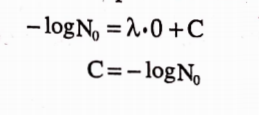
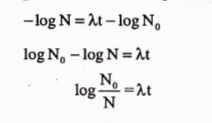
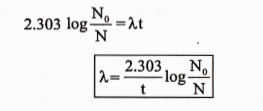



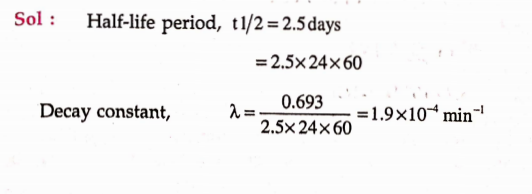
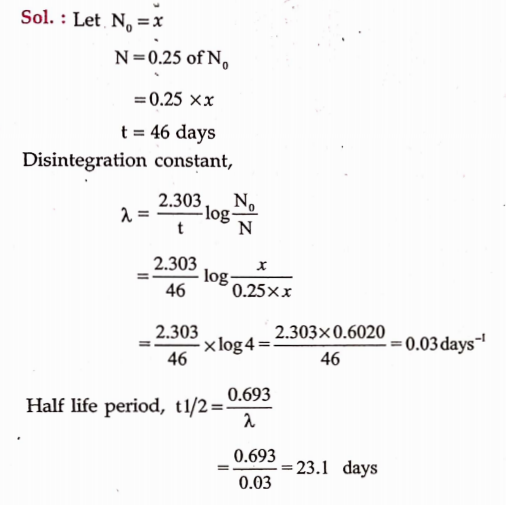


![]()


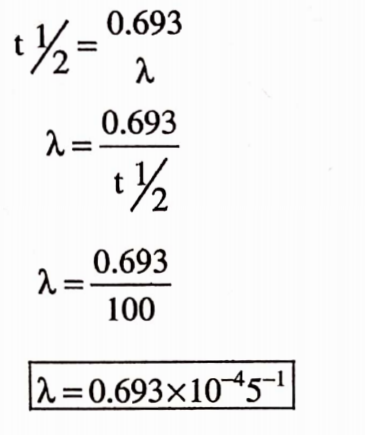

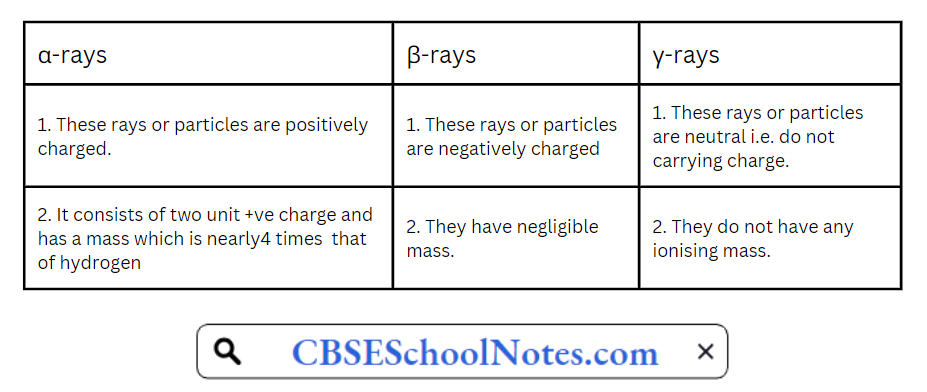

![]()


